
WhatsApp 訊息範本:包含 13 個範例的操作指南
除非使用 WhatsApp 訊息模板,否則企業無法在 24 小時後發送 WhatsApp 訊息。 了解如何格式化和傳送範本訊息以及範例。

Facebook 廣告長期以來一直是數位行銷的主要內容,但現在'出現了一個強有力的競爭者:TikTok 廣告。 這個新選項為企業打開了一個充滿可能性的世界,但問題仍然存在——TikTok 廣告與 Facebook 廣告相比如何? 在此比較中,我們將深入研究每個平台的獨特功能和優勢,以幫助您決定哪個平台最能支援您的銷售和行銷目標。 讓我們深入了解吧!
TikTok 提供兩種不同類型的點擊訊息廣告,每種廣告都適合不同的管道,以便在初次互動後進行持續對話。 首先,我們有 TikTok 直接訊息廣告。 這些允許用戶直接在 TikTok 內發起對話。
另一方面, TikTok 即時通訊廣告 將用戶引導至 WhatsApp 或 Facebook Messenger 等流行的訊息平台——您的客戶可能每天都會在這些平台上互動。
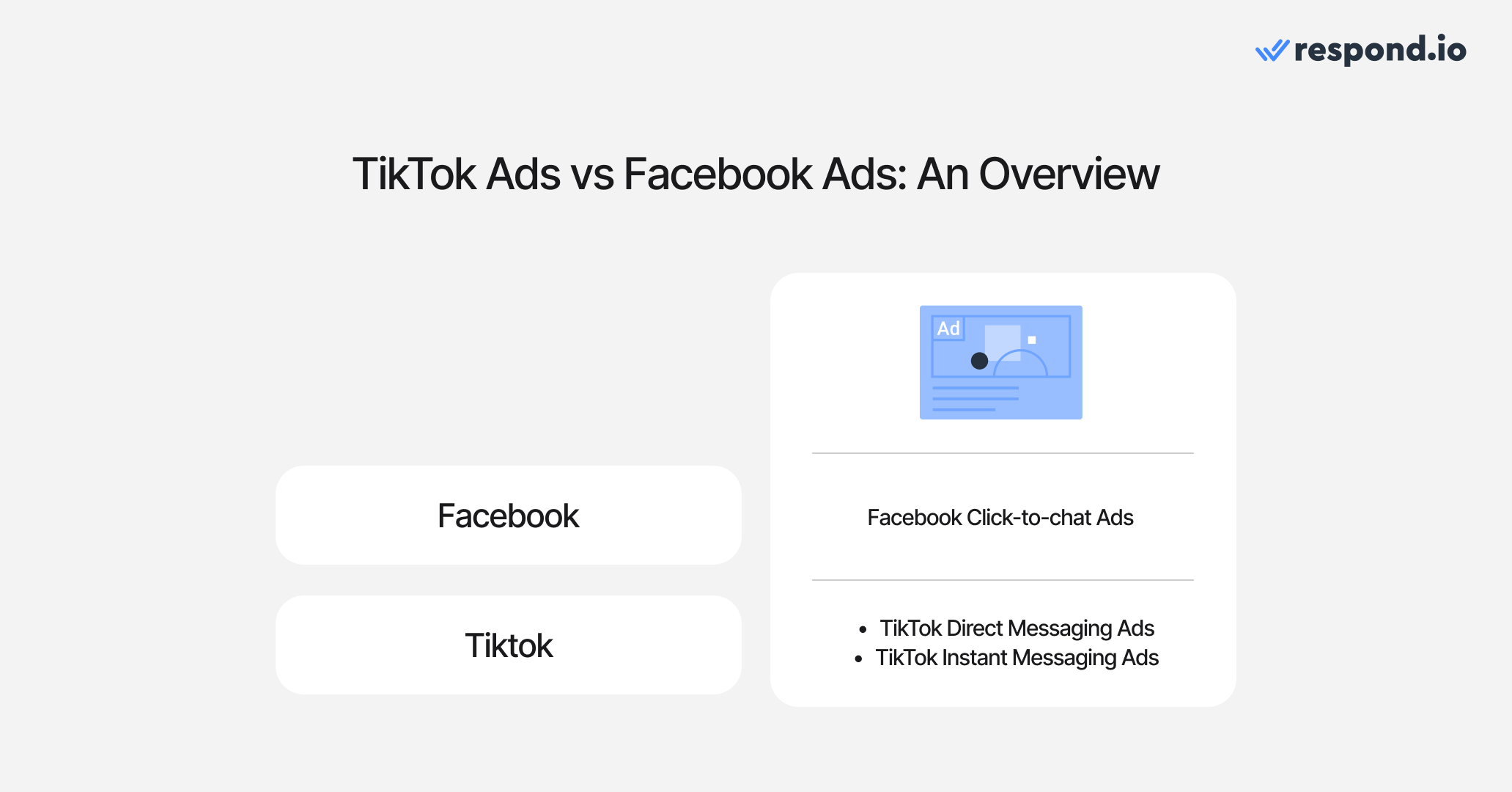
同樣, Facebook 點擊聊天廣告 透過將 Facebook 和 Instagram 上的潛在客戶直接引導到 Messenger 聊天中來促進溝通,鼓勵他們與您的品牌直接互動。
您應該知道,Meta 也提供了 Facebook 廣告的替代品,例如 WhatsApp 或 Instagram Direct 廣告。 它們的運作方式與 Facebook 廣告類似:您可以在 Facebook 或 Instagram 上做廣告,並分別在 WhatsApp 和 Instagram DM 上捕獲對話。
TikTok 廣告以旨在快速吸引註意力的簡短、引人入勝的影片而蓬勃發展,而 Facebook 廣告則利用多種格式和高級定位選項來覆蓋特定人群。 那麼,如何確定最適合您業務的平台呢?
對於 TikTok 來說,最受歡迎且最具成本效益的選項包括 Spark 廣告和資訊流廣告。 對於尋求更高知名度的企業,可以使用頂級廣告、標籤挑戰和品牌鏡頭等優質展示位置。
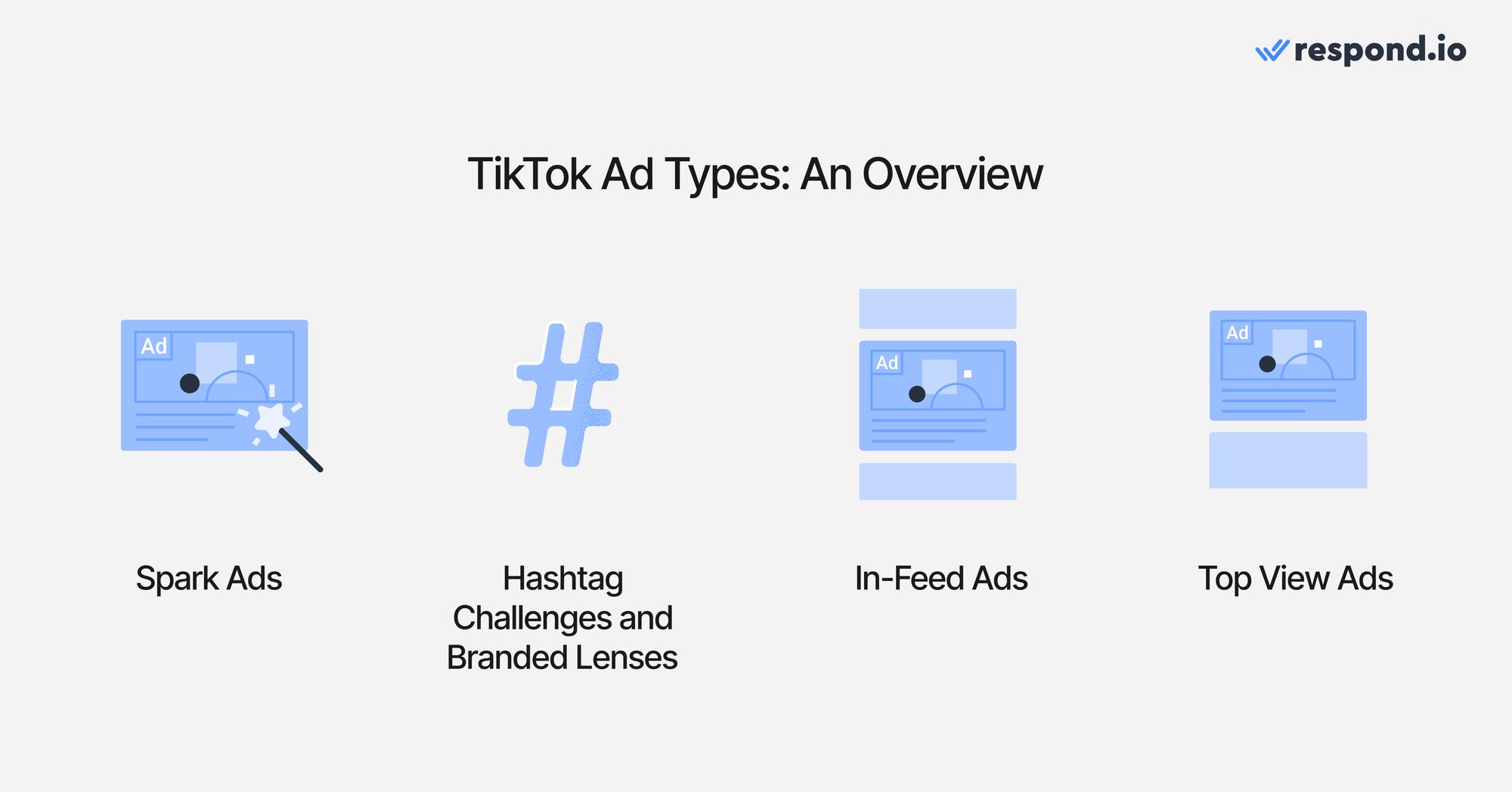
Spark 廣告:這種格式使企業能夠推廣現有的有機內容或用戶生成的內容,在保持真實性的同時擴大高績效帖子的影響範圍。
資訊流廣告:這些廣告融入 TikTok 用戶' 訊息流中,在不影響用戶體驗的情況下吸引他們的注意力。 高度可自訂的資訊流廣告適合各種行銷預算。
標籤挑戰和品牌鏡頭:這些功能鼓勵用戶圍繞特定主題創建和分享內容,利用創造力和參與度進行潛在的病毒式行銷活動。
頂視圖廣告:這些廣告在用戶打開TikTok 應用程式時放置在顯著位置,以較高的成本保證高可見度和參與度,非常適合旨在給人留下深刻第一印象的品牌。
相比之下,這正是 Facebook 廣告所提供的。
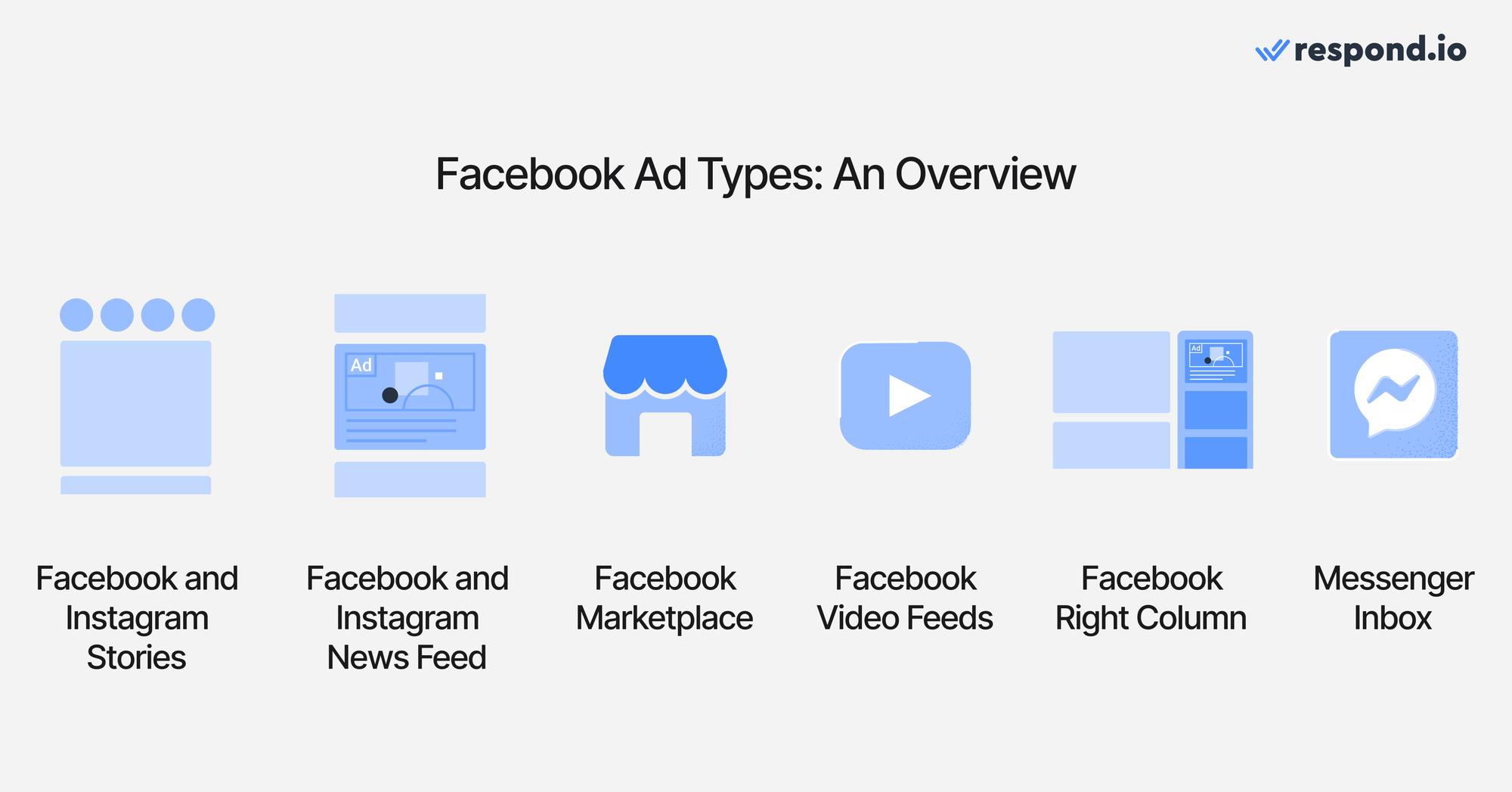
Facebook 和 Instagram Stories:這些沉浸式全螢幕廣告出現在 Stories 中,非常適合吸引註意力的時間敏感內容。
Facebook 與 Instagram 動態消息:此處的廣告與使用者內容有機融合,以提高參與度。
Facebook Marketplace:針對活躍購物者,這些廣告出現在專門用於買賣的空間中,使其與電子商務品牌非常相關。
Facebook 影片動態:廣告可以出現在影片內容中,透過影片廣告增強故事講述。
Facebook 右欄:較小但在桌面上可見,這些廣告通常用於重定向行銷活動。
Messenger 收件匣:這些廣告是為個人化參與而設計,透過訊息傳遞推動直接對話。
這兩個平台都提供全面的定位選項,包括:
人口目標
興趣定位
行為定位
設備定位
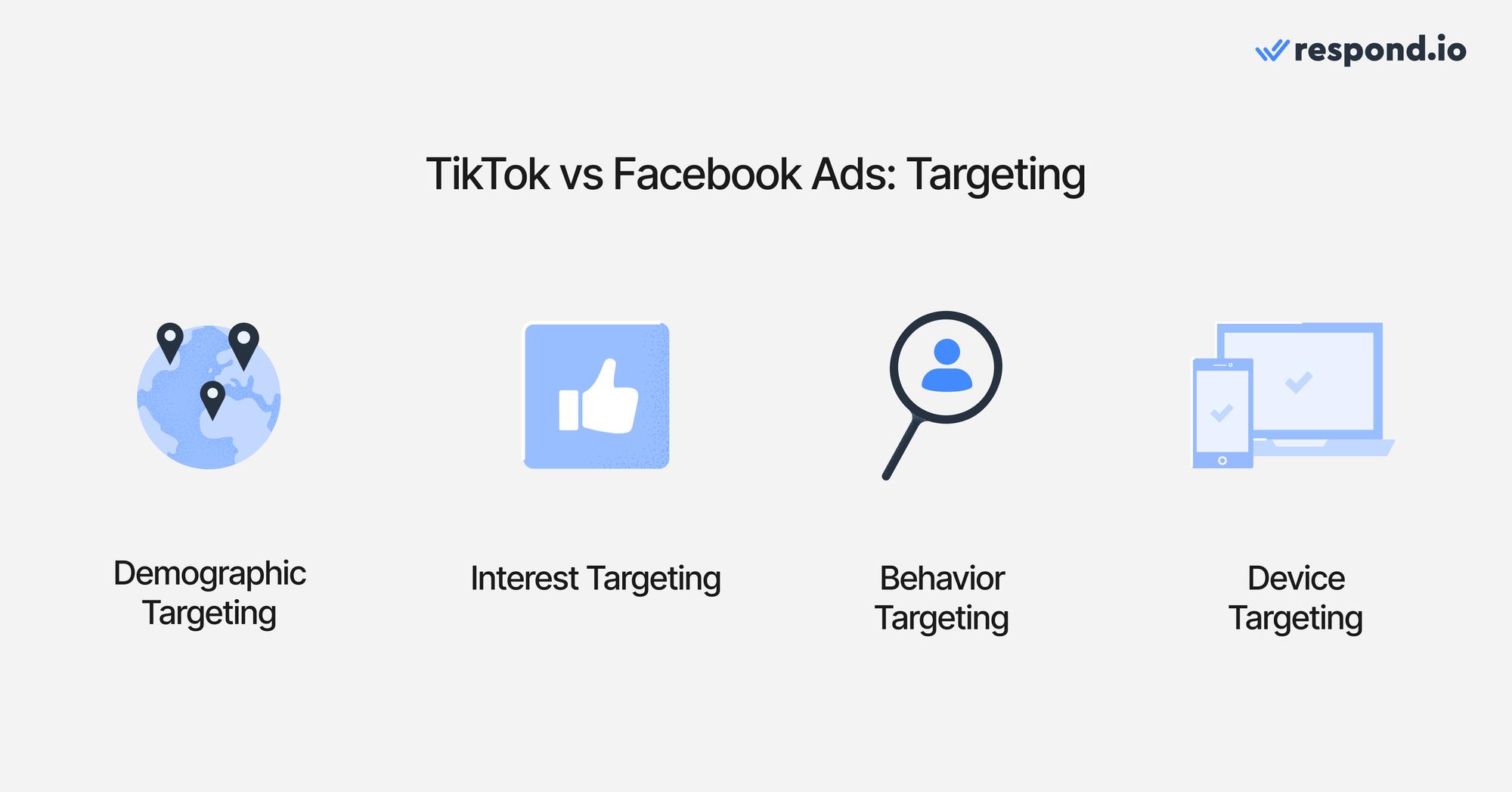
然而,Facebook 提供了更先進的定位功能和更廣泛的受眾數據。 例如, Meta Pixel 可以根據您網站上的使用者操作(例如購物車新增或購買)進行精確定位。
雖然 TikTok 的演算法提供了直覺的定位,但 Facebook'的機制提供了更精細的方法。
在分析方面, Facebook 的廣告管理器 可以深入了解廣告活動的效果,而 TikTok 廣告管理器 則更為基礎。 不過,這也是很自然的,因為 TikTok 廣告是一項較新的功能,我們可以期待未來會有更多改進。
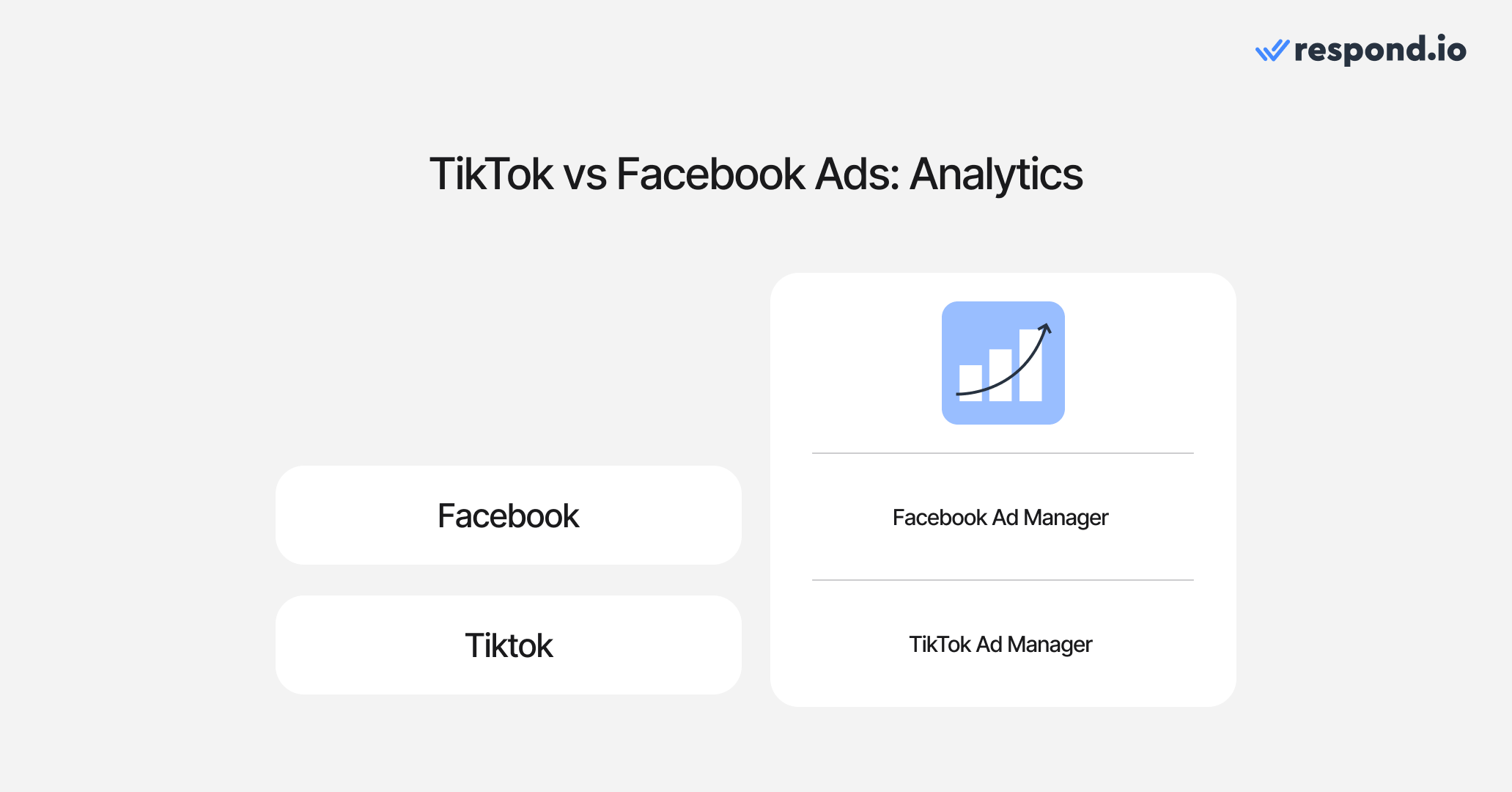
整體而言,Facebook 在績效追蹤方面具有優勢。
Facebook 擁有豐富的用戶數據,讓廣告主深入了解目標受眾的人口統計、興趣、行為和線上活動。 這些數據使企業能夠創建高度個人化和有針對性的廣告。
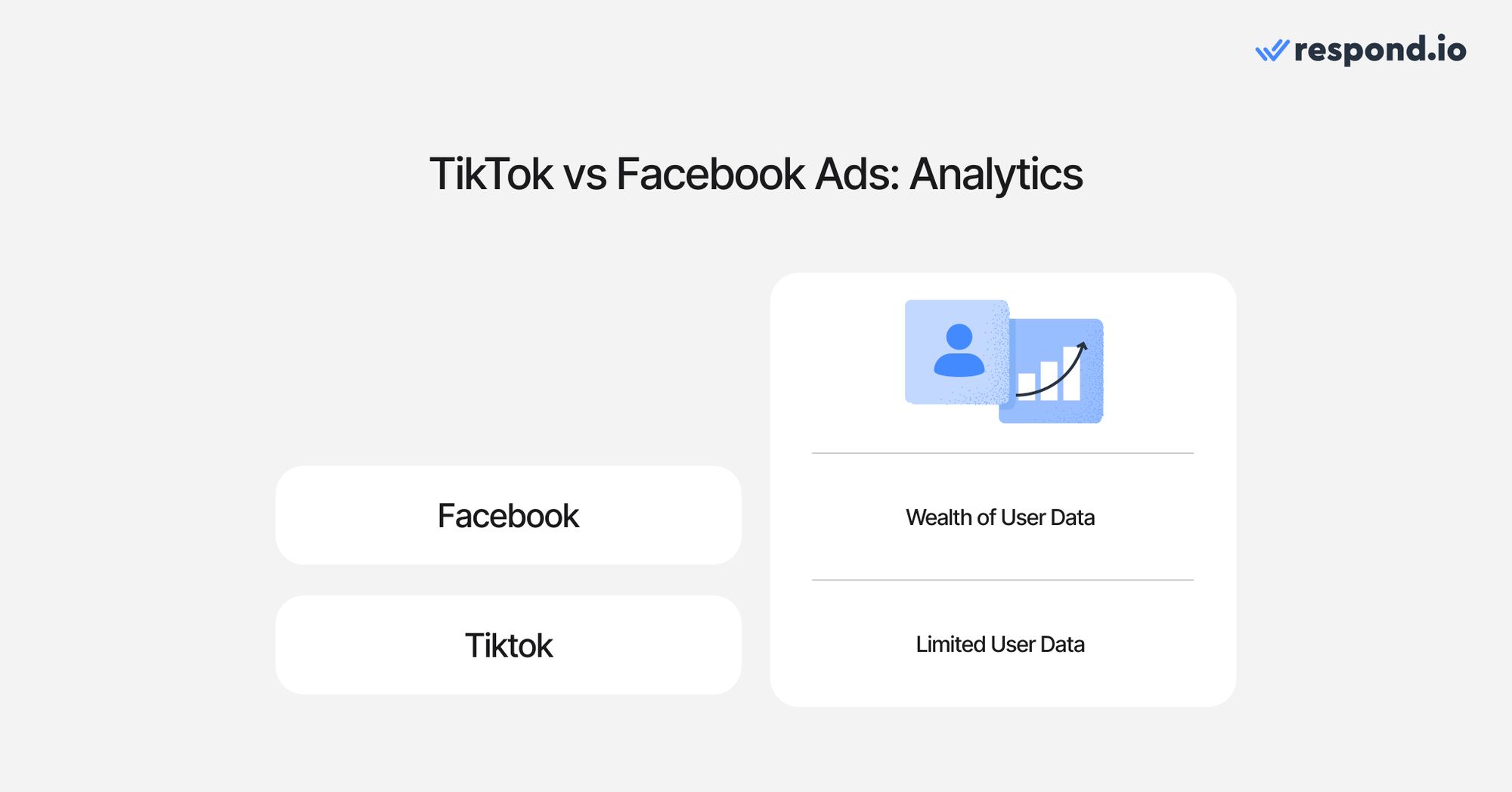
TikTok 廣告提供的受眾數據有限,這使得廣告商很難收集有關其受眾群體的詳細資訊。 然而,TikTok 的用戶群以年輕且參與度高而聞名,這對於針對該族群的品牌來說可能是有利的。
Facebook 和 TikTok 都有嚴格的廣告政策,廣告商必須熟悉這些政策,以確保合規並避免廣告被拒絕或帳戶被暫停。
Facebook 提供多種具有詳細定位功能的廣告格式,但圍繞敏感主題、政治廣告和資料隱私執行嚴格的指導方針。 政治廣告是允許的,但要求披露,而錯誤訊息和歧視性做法等內容則被禁止。
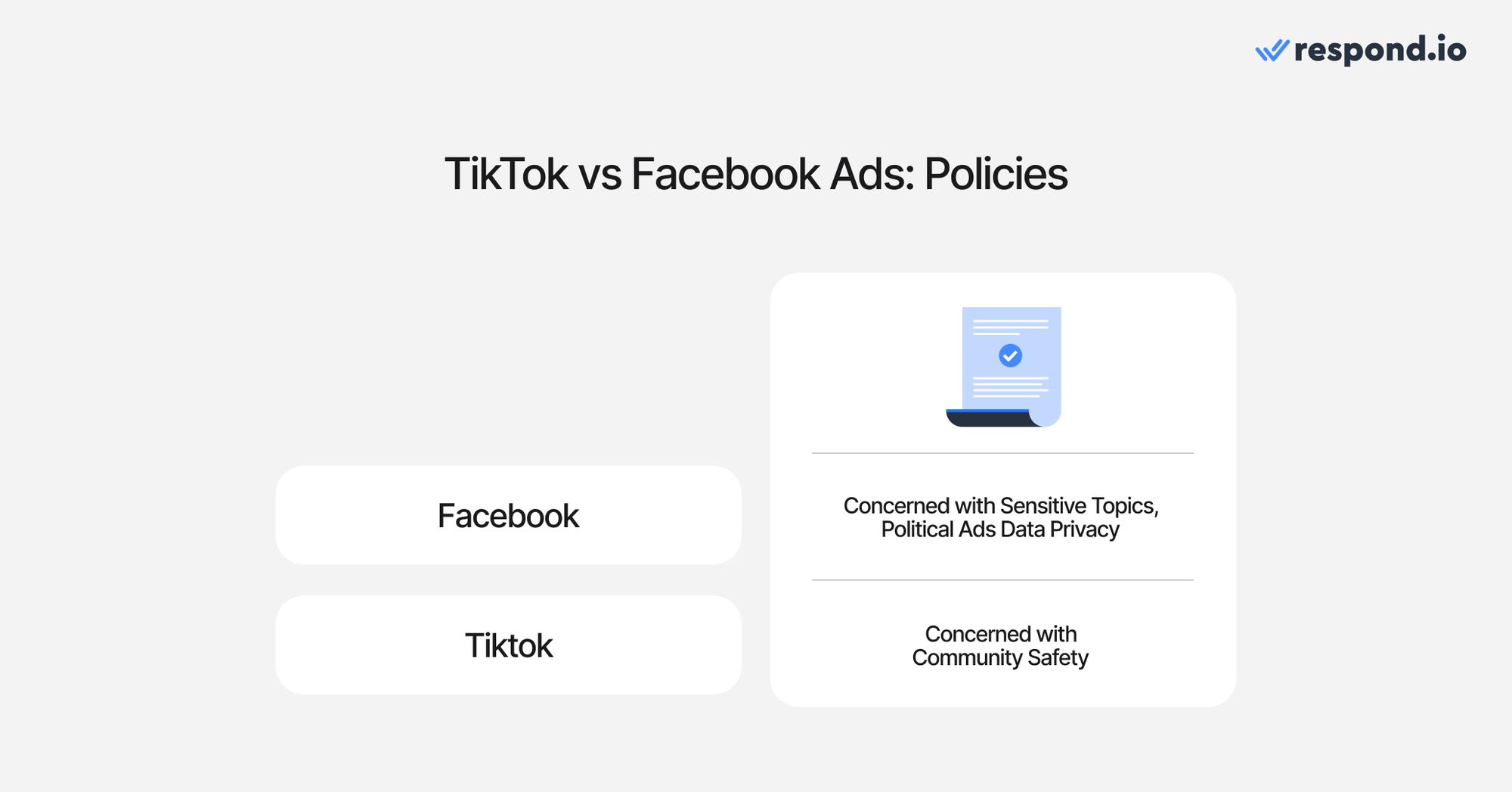
然而,TikTok 的重點是透過禁止政治廣告並高度重視社群安全來保護年輕受眾。
TikTok 廣告必須遵守有害內容的嚴格規則,特別是有關身體形象的內容,並旨在鼓勵創造力和用戶參與。 這兩個平台都要求為影響者行銷提供清晰的標籤,但 TikTok 優先考慮真實性和有機內容。
Facebook 服務於廣泛的行業,使其成為各個行業企業的主要業務。
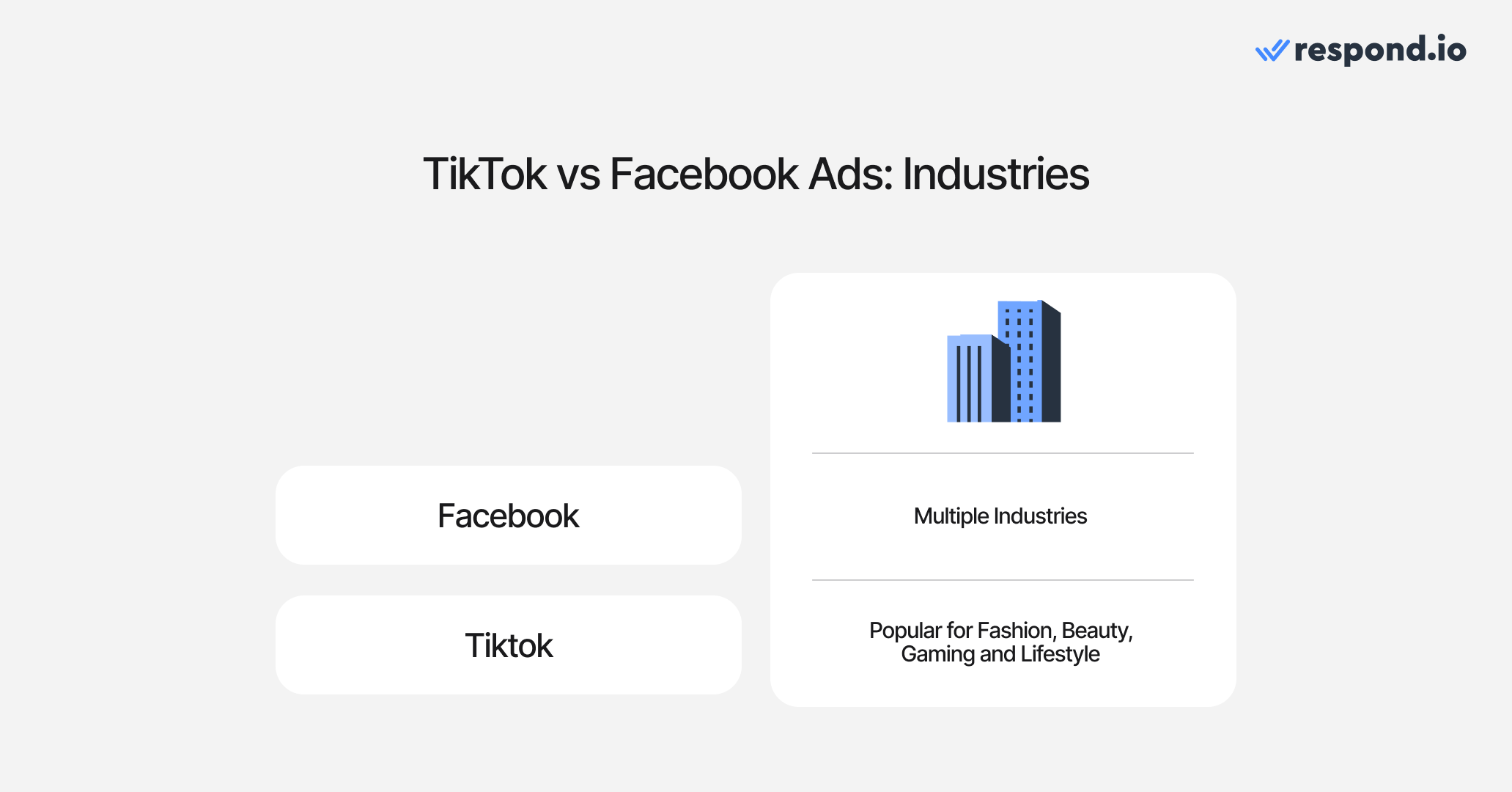
相比之下,TikTok 尤其吸引針對年輕受眾的品牌,時尚、美容、遊戲和生活方式等行業在該平台上蓬勃發展。
Facebook'的資料收集非常詳細且廣泛,為廣告商提供了廣泛的使用者資訊。 Facebook 廣告收集:
人口統計:年齡、性別、地點和教育程度等資訊。
行為資料:來自互動歷史記錄、應用程式使用情況、購買行為和線上活動的見解。
興趣資料:基於瀏覽歷史記錄的喜歡頁面、內容參與度和偏好的資料。
第三方資料:Facebook 與外部資料經紀人合作,透過整合線下行為(包括購買歷史記錄和忠誠會員資格)來增強目標定位。
參與度資料:按讚、分享、評論和整體內容參與度等指標。
設備資訊:有關設備類型、作業系統和瀏覽行為的詳細資訊。
TikTok | ||
|---|---|---|
人口統計數據 | 是(年齡、性別、地點、教育程度) | 是(年齡、性別、地點) |
行為數據 | 是(互動歷史、應用程式使用、購買行為、線上活動) | 有限(專注於應用程式內參與度,而不是外部瀏覽歷史記錄) |
興趣數據 | 是(喜歡的頁面、內容參與度、瀏覽歷史偏好) | 是(根據內容參與模式推論) |
第三方數據 | 是(包括離線行為、購買歷史、忠誠會員資格) | 有限(包含來自合作夥伴廣告商的一些數據) |
參與數據 | 是(喜歡、分享、評論或整體內容參與度) | 是(影片按讚、分享、留言、觀看時間) |
設備資訊 | 是(設備時間、作業系統、瀏覽記錄) | 是(設備類型、作業系統、瀏覽記錄) |
音訊 & 視覺數據 | 否(不關注音訊和視訊資料) | 是(分析上傳的影片、聲音和物體) |
相較之下,TikTok 的資料收集主要集中在應用程式內行為和內容偏好。 TikTok 廣告收集:
人口統計:年齡、性別和地點等基本資料。
參與度資料:來自視訊點讚、分享、評論和觀看時間的指標,TikTok 使用這些指標來完善演算法和推薦內容。
設備資訊:有關設備類型、作業系統和瀏覽歷史記錄的資訊。
音頻和視頻數據:分析上傳的視頻,包括聲音和檢測到的對象,以更好地分類和投放相關廣告。
興趣資料:根據使用者對內容的參與模式推斷。
第三方資料:來自廣告商或合作夥伴的有限資料合併。
在 TikTok 上吸引用戶,在 respond.io 上轉換 ✨
立即使用 TikTok 訊息廣告提升您的 TikTok 策略!
了解關鍵指標,例如 CPM(每千次成本)、 CPC(每次點擊成本)、 CTR(點擊率) ) 和 CVR(轉換率) 對於評估廣告效果至關重要。 讓我們深入研究這些指標,以了解哪個平台更適合您。
CPM 反映的是每 1,000 次展示的費用。
TikTok:平均每千次展示費用約為 $10,而據報告指出,或有更低的費用可低至 $3.21,這使其對於針對年輕受眾的品牌非常具有吸引力。
Facebook:平均約為 7.19 美元,Facebook 提供有競爭力的價格,具體價格根據行業和目標而有所不同。
CPC 表示廣告的每次點擊費用。
TikTok:平均每次點擊費用為 $1.00,TikTok 的引人入勝的格式使其具有競爭力,儘管它可能會因定位而波動。
Facebook:與 TikTok 相匹配,價格約為 1.00 美元,Facebook 廣泛的定位功能提供了針對特定行業優化 CPC 的靈活性。
點擊率衡量廣告參與度。
TikTok:平均 0.84%,TikTok 的點擊率凸顯了其創意內容的吸引力。
Facebook:平均點擊率約為 0.9%,Facebook 的生態系統可以根據行業產生更高的點擊率。
CVR 顯示使用者完成所需操作的百分比。
TikTok:TikTok 的平均 CVR 為 0.46%,在參與度方面表現出色,但在推動年輕受眾的轉化方面可能面臨挑戰。
Facebook:Facebook 擁有較高的平均轉換率(CVR) 9.21%,Facebook 強大的定位和重定向選項使其成為以轉換為重點的營銷活動的理想選擇。
TikTok | ||
|---|---|---|
每英哩費用 (CPM) | 10 美元,低至 3.21 美元 | 7.19 美元 |
每次點擊費用 (CPC) | 1.00 美元 | 1.00 美元 |
點擊率 (CTR) | 0.84% | 0.9% |
轉換率(CVR) | 0.46% | 9.21% |
這些指標可以幫助您了解哪個平台符合您的廣告目標。 TikTok 可能是您預算友好的選擇,而 Facebook 可以提供更高品質的點擊——找到適當的平衡是關鍵。
在不同層面比較了 TikTok 廣告與 Facebook 廣告後,讓我們來談談它們的優缺點。
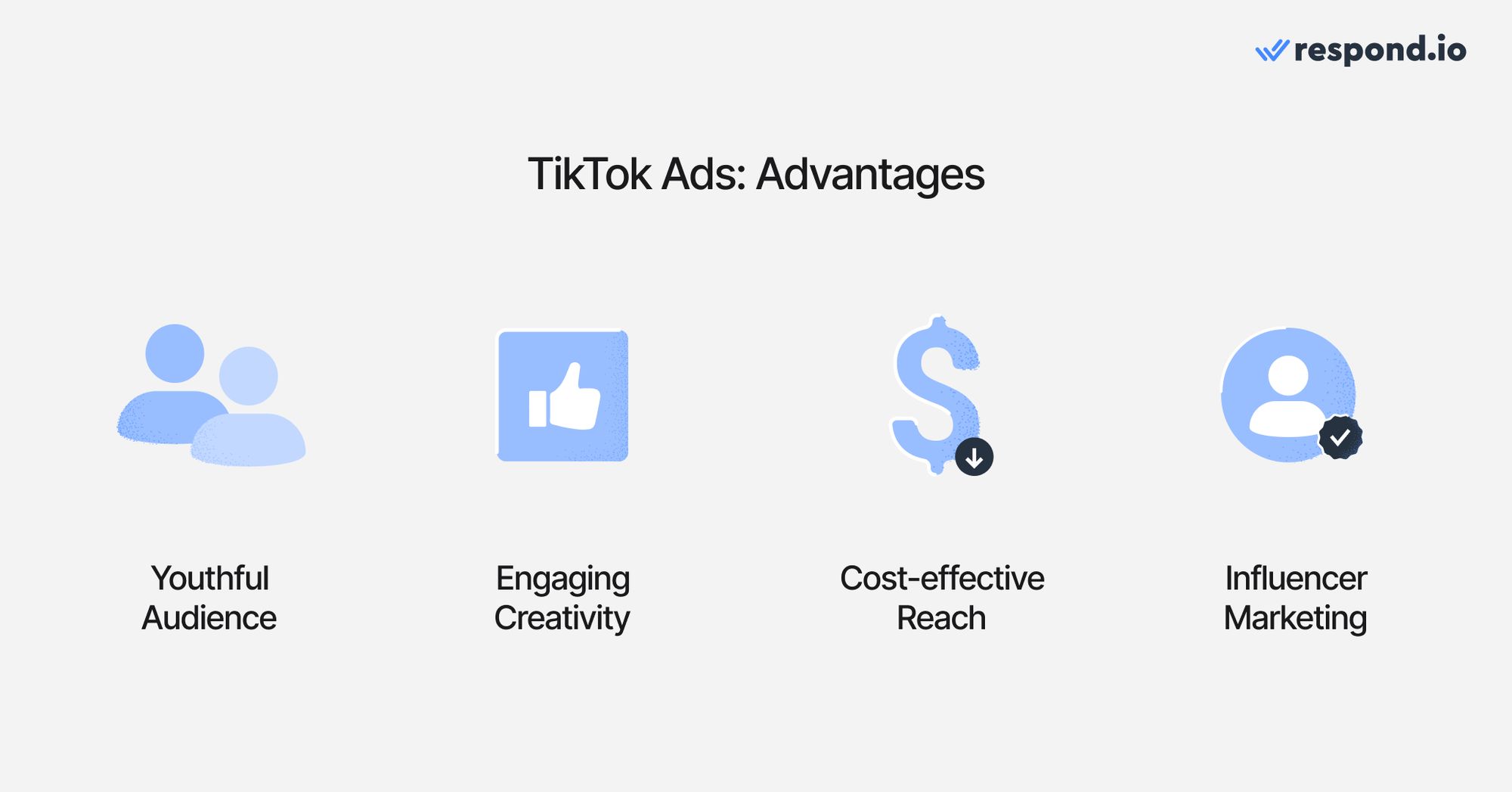
年輕受眾:TikTok 非常適合針對 Z 世代和千禧世代的品牌,是年輕用戶的熱點。
激發創造力:平台的短視頻格式鼓勵講故事和創造力,使廣告具有娛樂性和吸引力。
成本效益達到:TikTok 通常提供較低的 CPM 和 CPC 費率,提供具有成本效益的廣告選擇。
影響者行銷:與創作者合作,產生與您的品牌相符的真實內容。
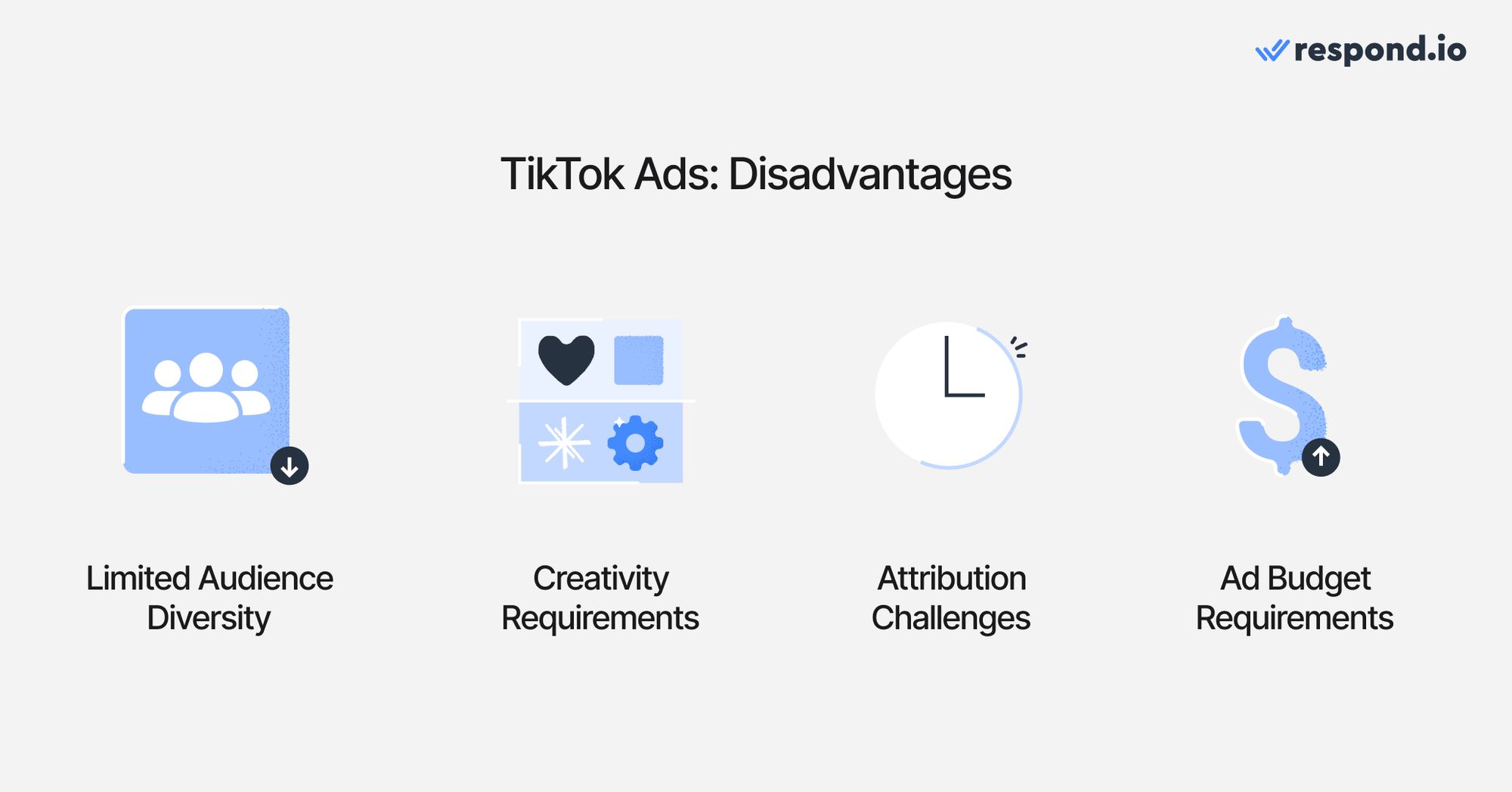
有限的受眾多樣性:TikTok 主要吸引年輕人群,可能不適合針對老年受眾的品牌。
創意要求:成功取決於您製作引人入勝且富有創意的內容的能力。
歸因挑戰:較短的歸因視窗會使衡量廣告活動影響變得複雜。
廣告預算要求:某些 TikTok 功能可能有很高的最低預算要求。
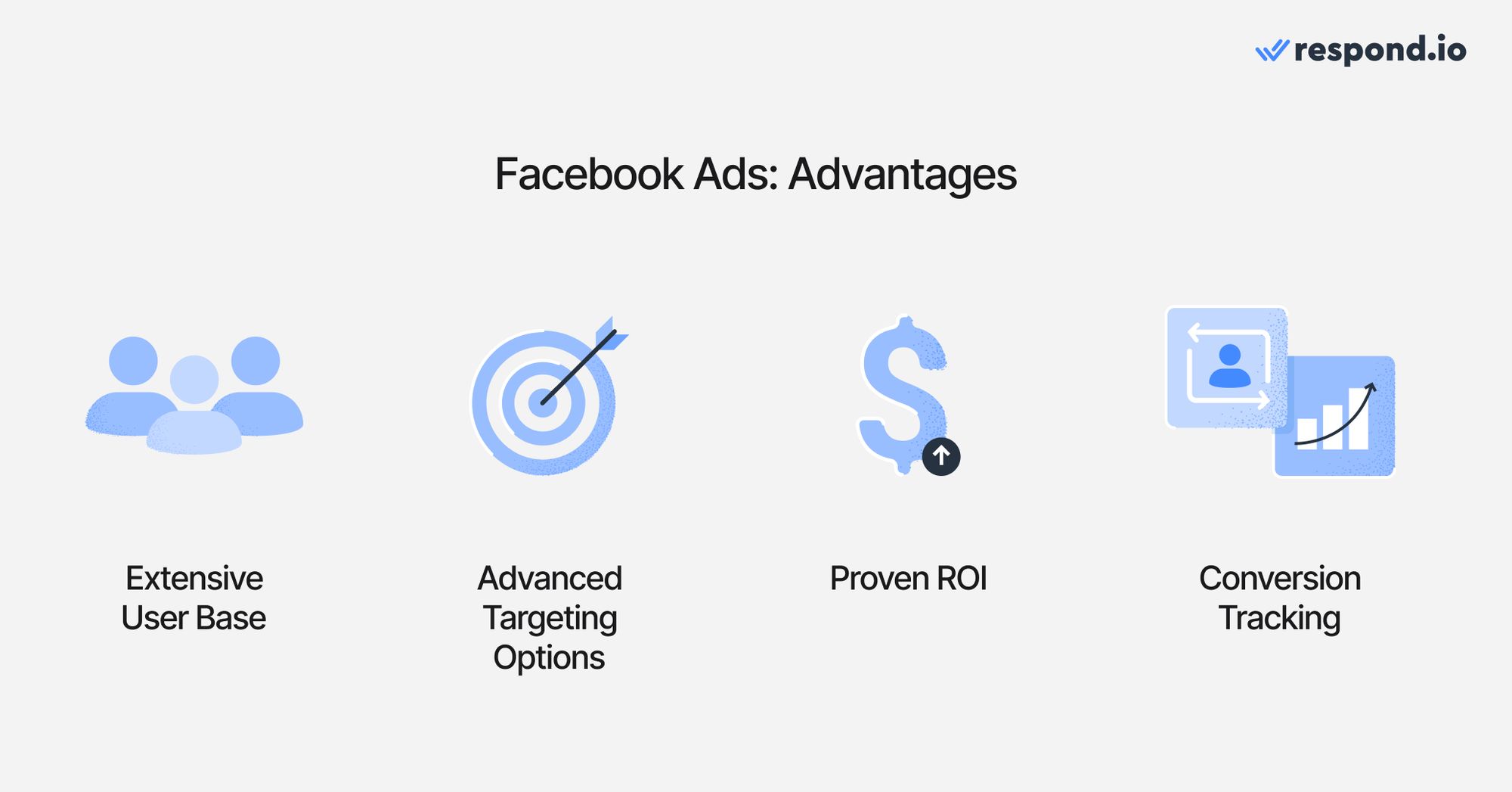
廣泛的用戶群:Facebook 的多元化受眾跨越多個年齡層和人口統計。
進階定位選項:Facebook 的定位非常精確,可將您的廣告引導給最相關的使用者。
經驗證的投資報酬率:許多企業透過 Facebook 廣告獲得了可觀的投資回報。
轉換追蹤:強大的工具提供對行銷活動績效的詳細洞察,有助於優化工作。
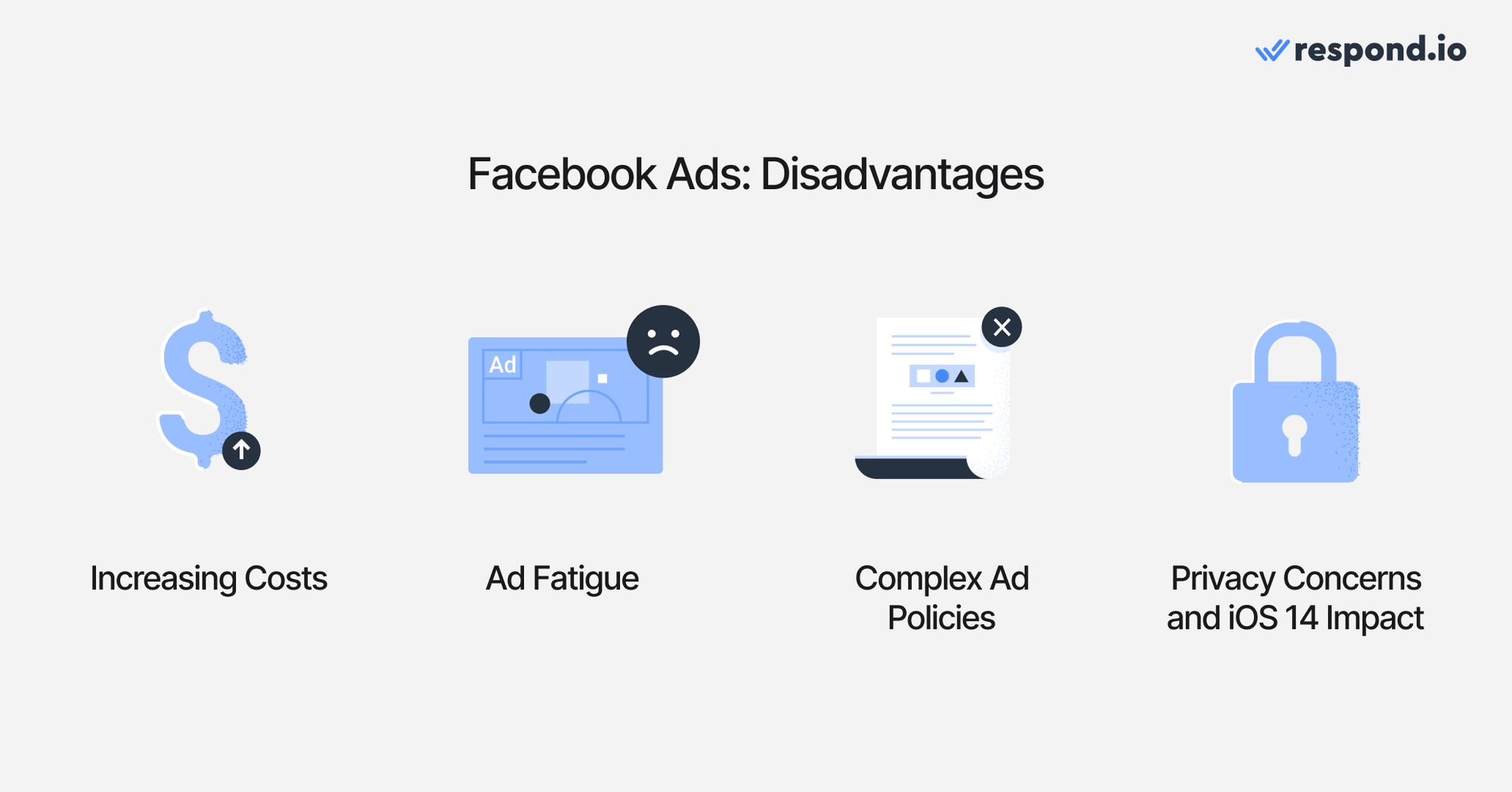
成本增加: Facebook 廣告的日益普及可能會導致成本上升。
廣告疲勞:使用者可能會因接觸大量廣告而變得反應遲鈍。
複雜的廣告政策:如果不遵守嚴格的準則,可能會導致廣告被拒絕或帳戶問題。
隱私問題和 iOS 14 影響:最近的隱私法規影響了定位和追蹤功能。
到目前為止,您可能已經更清楚地了解哪個平台最適合您的數位廣告。 如果您還不確定,請不要錯過此部分。 在這裡,我們將總結本部落格的主要見解,並就 TikTok 還是 Facebook 是否最適合您的廣告目標提供建議。
Facebook 廣告 | TikTok 廣告 | |
|---|---|---|
最適合: | 針對更廣泛的人群(從 Z 世代到嬰兒潮世代) | 透過創意內容吸引年輕受眾(Z 世代和千禧世代) |
內容類型 | 多種廣告形式,滿足不同目標 | 與熱門內容相符的簡短、引人入勝的影片廣告 |
最適合 | 以直接銷售和潛在客戶生成為重點的轉換驅動型行銷活動 | 品牌宣傳活動、影響力合作、視覺驅動 |
優點 | 進階定位選項、精準的受眾細分、強大的轉換率 | 較低的 CPM 和 CPC 費率,適合較大受眾群體,經濟實惠 |
當您的企業希望透過極具創意和娛樂性的內容吸引年輕受眾(主要是 Z 世代和千禧世代)時,TikTok 廣告是理想的選擇。
TikTok'的視訊驅動平台依靠與熱門內容一致的簡短、引人入勝的廣告而蓬勃發展,使其非常適合品牌知名度活動、影響者合作以及吸引視覺驅動市場的產品。
此外,較低的每千次展示費用和每次點擊費用使其成為旨在經濟高效地吸引大量受眾的企業的預算友好型選擇,尤其是在時尚、美容和娛樂等行業。
Facebook 廣告最適合針對涵蓋多個年齡層(從 Z 世代到嬰兒潮世代)的更廣泛人群的企業。
憑藉先進的定位選項和精確的受眾群體細分,Facebook 非常適合專注於直接銷售、潛在客戶開發或客戶保留的轉換驅動行銷活動。
其強大的轉換追蹤工具使衡量投資回報率和優化績效行銷活動變得更加容易。 如果您的企業需要詳細的受眾洞察或重新導向功能,Facebook 可以提供經過驗證的投資報酬率和豐富的分析來幫助您調整策略。
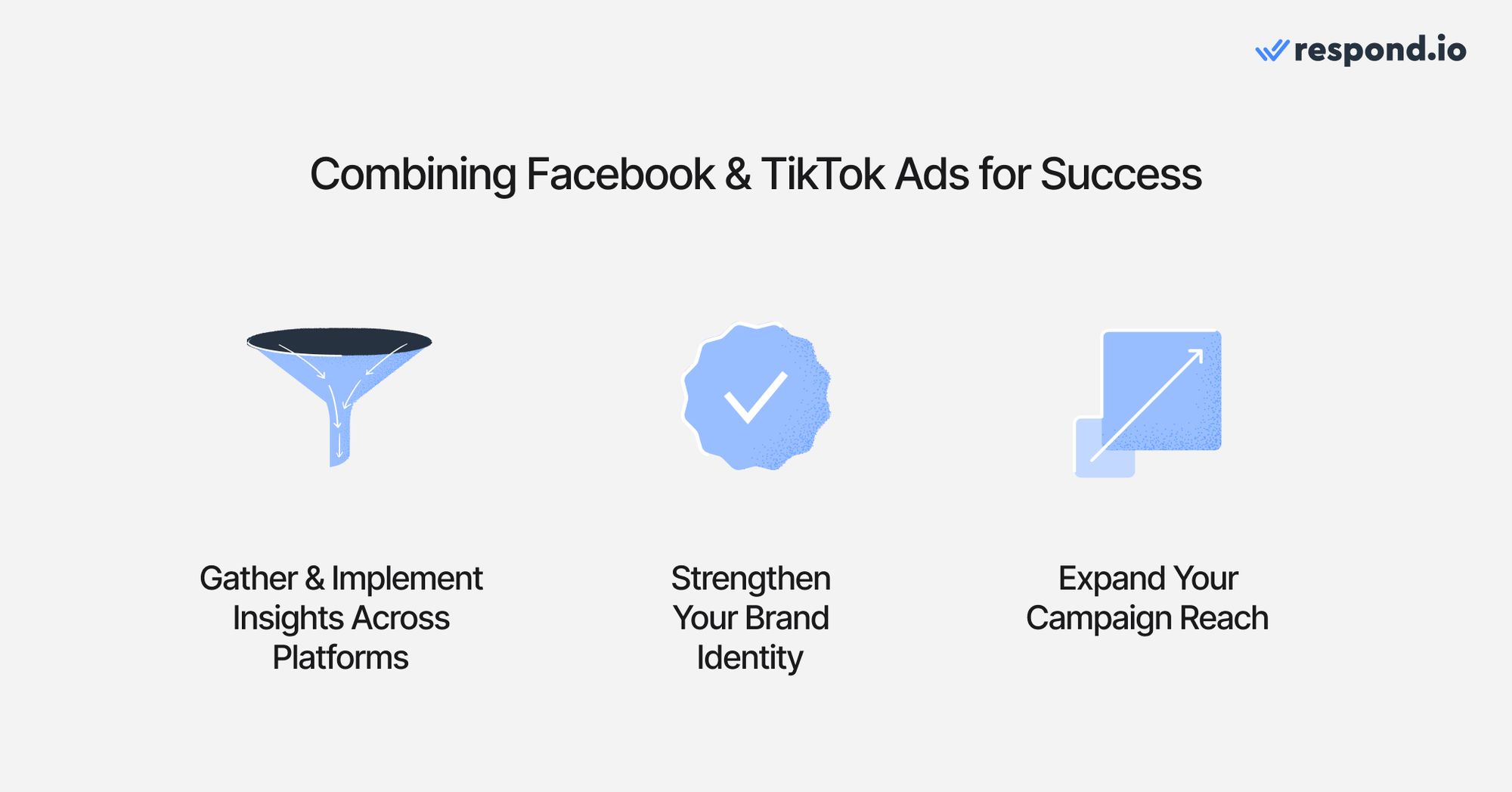
如果您想在當今的環境中發展業務,跨通路廣告策略是必須的。 這意味著在不同的管道(如搜尋和社交)以及這些管道內的不同平台(如社交中的 TikTok 和 Facebook)投放廣告。
跨多個社交媒體平台開展廣告活動使您能夠收集更多見解並應用更多知識。 請務必經常分析 TikTok 和 Facebook 上的活動報告,以發現這些有價值的跨平台機會。
在這些平台上保持清晰的語氣,使用相同的品牌元素(顏色、字體、圖像、氛圍),並定期與兩個網路上的受眾互動。 一致性是在消費者之間建立信任的好方法,因此請使用 Facebook 和 TikTok 作為您品牌的啟動板。
TikTok 和 Facebook 都可以讓您接觸到獨特的受眾和特定的人口統計數據,因此請充分利用這一點。 對不同的目標受眾進行試驗,以發現新的潛在客戶,並確保兩個平台都有足夠的預算來擴大規模。
🚀 大新聞! TikTok 即時通訊廣告現已在亞太地區上線,並在拉丁美洲處於測試階段! 現在,企業可以透過 WhatsApp 和 Messenger 與 TikTok 潛在客戶聯繫,提供諮詢、安排約會和完成銷售——所有這些都可以在一次對話中完成。
🔥 獨家優惠: 當您整合 respond.io 並優化您的營銷活動以促進對話時,可享受 TikTok 即時消息廣告支出 50% 的折扣。
這取決於多個變數。 然而,通常情況並非如此。 平均而言,TikTok 廣告的每次點擊費用 (CTC) 和每英里費用 (CPM) 比元廣告便宜。
同時使用 Facebook 廣告和 TikTok 廣告可以幫助品牌接觸更多人並實現其行銷目標。 TikTok 非常適合製作有趣的視頻,讓人們對某個品牌感興趣,而 Facebook 則適合針對特定群體並讓人們採取行動。
成本增加、廣告疲勞、複雜的廣告政策、隱私問題和 iOS 14 的影響。
受眾多樣性、創造力要求、歸因挑戰和廣告預算要求有限。
如果您喜歡閱讀本文,請查看以下其他部落格:
Román Filgueira 是維戈大學畢業生,擁有外語學士學位,於 2021 年加入 respond.io 團隊,擔任內容撰稿人。 Román 提供有關使用訊息應用程式推動業務成長的最佳實踐的專家見解。